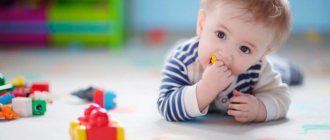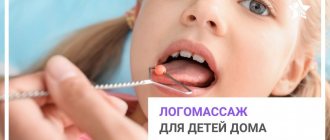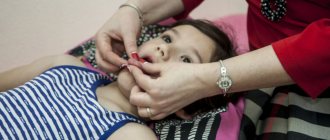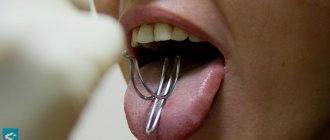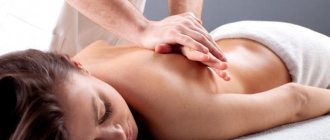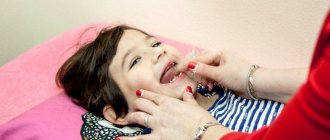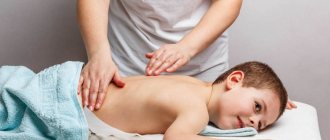Speech therapy massage is one of the methods used to correct speech. It is prescribed for complex pathologies when impaired muscle tone affects pronunciation. There are several proprietary methods used by speech therapists in their work. For some, you need to take special training courses, while other methods can be used by parents or the child himself at home. One of these author’s developments is speech therapy massage with spoons by O. I. Krupenchuk.
Its goal is to normalize muscle tone by stimulating certain points associated with the speech centers of the cerebral cortex. In this embodiment, they use spoons rather than probes with spatulas. During the massage, the speech therapist pronounces his actions, and the child repeats after him. Vernacularization of actions contributes to the development of speech. By working with this technique, you can not only normalize muscle tone, but also develop the pronunciation, lexical and grammatical aspects of speech.
Advantages of the technique O. I. Krupenchuk
Spoon massage is becoming increasingly popular not only in home exercises, it is also used in kindergartens. This method is effective and has a number of certain advantages over other options for speech therapy massage:
- The child does not have a negative reaction to cutlery. Many children do not like it when a speech therapist uses probes and spatulas in his work.
- To carry it out, you do not need to take special courses, so parents and children can do this massage at home.
- You can use different temperatures during classes, which makes it possible to carry out a relaxing or stimulating effect.
- This technique can be used in group and individual lessons.
Of course, for serious speech disorders, this technique will not be as effective as a probe. But if the child has a persistent negative reaction to probes and spatulas and if speech defects are not too complex (for example, erased dysarthria), it should be included in correctional classes.
Why a spoon?
This massage technique was first proposed by the famous cosmetologist Rene Koch. It just so happened that millions of women immediately picked up this idea and adopted it. Why exactly the spoon, why is the procedure so popular? It’s difficult to answer, but we assume that there are 3 main reasons:
- Spoons allow you to act on the deep subcutaneous layers of fat, allowing you to effectively eliminate the deepest damaged areas of the skin. In addition, uniform pressure helps improve lymph flow and normalize blood circulation, which also helps normalize the condition of the skin.
- Availability. Women all over the world have limited time. A girl who can afford to watch her diet, exercise, and take care of her health rarely encounters serious orange peel stretch marks or cellulite. Therefore, the ability to massage at home, without the need to purchase expensive or numerous additional tools, makes the spoon an effective remedy against cellulite.
- Safety. Many types of home massage are complex and impose many restrictions. Heart patients, people with hormonal imbalance, chronic diseases cannot use them. Massage with spoons is suitable for any area of the skin and is relatively safe and does not impose any restrictions.
General tasks of speech therapy massage
Any of its variations are aimed at solving the following problems:
- stimulation of speech centers of the cerebral cortex;
- reduction or cessation of seizures, synkinesis;
- normalization of muscle tone;
- improving the functioning of articulation organs;
- improving the functioning of facial muscles.
Often during a session, the specialist voices his actions, focusing the child’s attention on sensations and the position of the organs of articulation. Therefore, speech therapy massage is an effective means of speech correction.
How often to perform the procedure
The frequency of the procedure, the duration of the procedure and the intensity depend on the physiological characteristics of the body, the problem area of the skin, as well as on the technique. On average, the duration of exposure to one area of skin does not exceed 5-10 minutes. If you preheat the spoons, the effectiveness of contact can increase, and the exercises themselves can be carried out using different techniques.
The face is a special part of the body; here you should exercise maximum delicacy and caution. If you massage above the eyebrows, it is enough to move the spoon along the massage lines 5-6 times, this is quite enough.
If we are working on problem areas in the abdominal area, then it is worth carrying out the procedure for at least 10 minutes, because... The abdominal area is quite large. You should choose the following massage techniques: duck feet, drum or zigzag. You can successfully combine and combine several types of massage at once.
The goals of O.I.’s methodology Krupenchuk
Of course, massage with spoons is aimed at solving common problems. But it also has specific goals that need to be taken into account during classes:
- securing various positions of the spoon in the hand;
- development of fine motor skills;
- improving coordination of movements and the ability to navigate in space;
- correction of speech development.
All manipulations are performed while short poems are recited. This contributes to the development of the tempo-rhythmic side of speech, which affects the syllabic structure of the word.
Execution technique
You can massage with spoons on any area of the skin, but it is most widely used and is used in the facial area. The technique is approximately the same and it is suitable for both the facial area and the décolleté or back:
- Treating spoons with an antiseptic. After processing and procedure, spoons should be stored separately from cutlery.
- Facial cleansing. Scrubs, masks - any of your favorite products to cleanse the skin and pores, thus we will prepare the face (body) for the procedure.
- Apply anti-cellulite oil or cream to the skin area. Objective: to moisturize the skin as much as possible to make sliding the spoon as simple and easy as possible.
- Pressure should be applied with spoons using uniform movements, without excessive enthusiasm and exclusively along the massage lines of the face.
- The degree of pressure is individual. Important: you cannot tolerate pain; this not only does not increase effectiveness, but also makes the procedure dangerous.
Features of conducting classes using the methodology of O. I. Krupenchuk
Be sure to wash your hands and cutlery before the specialist begins the session. At the beginning of the lesson, an adult introduces the children to the parts of a spoon. The child is first given one cutlery and asked to take it with the hand with which he usually holds it. The speech therapist recites the poem and shows the movements, and the kids repeat after him.
At first, they do not make any movements with their face, but simply carefully examine the cutlery:
- It is held vertically in front of the face and turned with a hole away from you and towards you.
- Holding a spoon in one hand, with the other hand they show and name all its parts.
Having mastered these actions, the children take the second spoon. All manipulations are now done synchronously. Then proceed to self-massage:
- Heaps of spoons stroking the lines of the forehead.
- Perform the same manipulations in the cheek area in a circle.
- Similar actions are performed in the temporal areas. Only apply gentle pressure at the end of each movement.
- The side side makes a movement in the direction from bottom to top along the cheeks.
- Stroking movements of the upper lip with the tips of spoons.
- Gent but frequent pressure over the entire surface of the lips with the same part of the spoon.
- Use heaps of spoons to knead the cheeks in a circle.
- The same manipulations, only in the direction from the corners of the mouth to the temples.
- Patting movements with heaps of spoons on the cheeks.
Each specialist can add his own movements, depending on the child’s characteristics. Due to the fact that it is possible to control the temperature of cutlery, it is possible to normalize the state of muscle tone. If they are warm, you will get a relaxing massage, which is necessary for increased tone. Cold spoons can have a stimulating effect, which is effective for hypotension.
Delayed speech development: how to help your child speak
№8 (185) September, 2018
Continuation.
Starts at No. 6(183). “Dysarthria”: diagnosis and speech therapy correction techniques
The fourth lesson is taught by clinical speech therapist-speech pathologist of the highest category, rehabilitation specialist at the Center for Child Neurology and Medical Rehabilitation, Tatyana Kalabukhova.
Good speech is the most important condition for the comprehensive development of children. The richer and more correct a child’s speech, the easier it is for him to express his thoughts, the wider his opportunities for understanding the surrounding reality. A child with well-developed speech easily enters into communication with others, he can clearly express his thoughts, desires, ask questions, and agree with peers about playing together. Conversely, a child’s slurred speech complicates his relationships with people and often leaves an imprint on his character.
Dysarthria is a speech disorder in which the movements of the articulatory apparatus are disrupted, that is, the mobility of the speech organs (lips, soft palate, tongue) is limited, and as a result, sound pronunciation is disrupted, speech becomes less intelligible, blurred and unclear. Children with dysarthria find it difficult not only to pronounce sounds, but also to chew and swallow. The voice of dysarthric children is quiet, weak, and sometimes harsh, hoarse. The rhythm of breathing is disrupted, speech loses its smoothness.
Depending on the area of brain damage, various manifestations of dysarthria are possible: from severe forms with swallowing problems. salivation, paresis of the muscles of the larynx, to mild “erased” forms, in which slurred speech with a nasal tinge is noted. There is even a “cold” form of dysarthria, which occurs only in a cold room or in winter.
There is a speech therapy classification based on the intelligibility of a child’s speech for others. There are 4 degrees of severity of speech impairment. From mild (I), which can only be detected with a special examination, to others this disorder may look like unclear diction.
To a severe (IV) degree, when the child’s speech is incomprehensible even to parents or is completely absent.
Since dysarthria is a neurological diagnosis, a speech therapist deals with the correction of impaired speech functions, and drug treatment is prescribed by a neurologist. Speech therapy work with dysarthric children should begin at an early age, since timely speech therapy help in 75% of cases helps to avoid many problems in the further development of the child. Dysarthria in infancy can manifest itself as:
- - difficulties in sucking breasts, bottles, pacifiers;
- - impaired swallowing during drinking, eating, swallowing saliva, the child chokes, often burps;
- - disorders of chewing and biting in older age.
At the Center for Pediatric Neurology and Medical Rehabilitation, I, as a clinical speech therapist, conduct speech therapy massage courses to stimulate sucking, swallowing, and subsequently chewing in children from 1 month, including children on tube feeding. Under the supervision of a specialist, the mother is taught the elements of a special massage to stimulate sucking and practice swallowing (massage should be carried out before each feeding). The need for the mother to keep a “Feeding Diary” of the baby is explained (taking into account regurgitation and supplementary feeding through a tube). Our main task is to remove the child from tube feeding and normalize his nutrition.
Recovery of the sucking reflex is slow; it can be stimulated by special speech therapy massage and acupressure stimulation at home:
*Massage of facial muscles
On a child's face, stroking and kneading are carried out with both hands evenly on both sides.
1. From the middle of the forehead to the temples.
2. From the middle of the forehead to the ears.
3.From the middle of the forehead to the ears and then through the cheeks to the chin.
4.From eyebrows to scalp.
5.From the back of the nose to the ears.
6.From the earlobes along the cheeks to the wings of the nose.
*Tongue massage
It is convenient to massage the tongue with a pacifier placed on a spatula, or with a finger in a fingertip.
1. Stroking the tongue from its middle to the tip. Gradually move closer to the root of the tongue.
2. Stroking from the midline of the tongue to the sides.
3. Patting over the entire surface of the tongue and along the edge of the tongue from top to bottom.
*Massage of lips and orbicularis oris muscle
Massage the child's lips is performed with the index or middle fingers of both hands.
1. Stroking above the upper lip and under the lower lip from the middle to the edges.
2. Kneading the lip between the thumb and index finger, “rubbing” the lip. The massage is performed on the upper and lower lips.
3. Fingers are placed in the corners of the mouth, lips are stretched into a smile, and then gathered into a “tube”.
At about 5 months, babies begin to put everything in their mouth, which is how they learn the movements of their jaws, tongue, and lips. If for some reason this does not happen, you can teach your child to bite and chew yourself, or seek help from a specialist.
Since biting and chewing are important parts of a child's learning to feed themselves, I recommend starting with special aids designed to provide stimulation and exercise to the lips, cheeks, tongue and gums. These can be teethers, vibrating sticks, syringes and other instruments. They can be found on speech therapy websites and in pharmacies.
The process of learning to bite and chew is long, so it is necessary to follow the sequence of work:
Stage 1 – Show your child how to bite so that the baby understands what this word means. This stage can be turned into a fun game if you take turns feeding the doll. Let the child feed you too. Use a sound or word (“bite”, “am-am”).
Stage 2 – Aimed at developing correct mouth opening when chewing. Place the teether between the chewing surfaces of the teeth and help the gums close and open. When doing this, use the word “bite”. Do this in front of a mirror so your baby can see him biting (if it doesn't distract him too much).
Stage 3 – After the child understands the word “bite” and learns how to do it, start chewing. Make up to 20-25 chewing movements on each side (in difficult cases, help with your hand, holding your chin and repeating the lowering and raising of the lower jaw in time with chewing).
Stage 4 – Use long teethers to develop bilateral chewing and increase jaw strength. Change sides to stimulate movement of chewing activity: 3-5 on one side, then on the other. Start with the side teeth, gradually moving to the back teeth.
Stage 5 - When the child has learned to bite and chew, dip the teether in puree while working - this will allow you to transfer the new skill to real food.
And praise, praise, praise the baby!
To overcome hypersalivation (excessive drooling) in children with dysarthria, it is necessary to teach the child to suck with closed lips, swallow saliva with his head thrown back and in his normal position. Drooling can be constant or worsen under certain conditions. Even mild drooling, such as wetness of the corners of the mouth during speech, or a slight leakage of saliva may indicate dysarthria. Before performing any articulation exercise, the speech therapist reminds the child to swallow saliva and blot the inside of the mouth with a napkin.
The main stages of speech therapy correction for hypersalivation:
1.Cryotherapy of active points in the lip area.
2.Rinse the mouth using medicinal herbs, mineral water, jelly and kefir.
3. Speech therapy massage and point massage.
4. Chewing solid food.
5.Static and dynamic facial and articulation exercises.
6. Breathing exercises and pronouncing vowels on a firm attack.
Recommendations from a speech therapist for parents with hypersalivation in children:
- — People around you should constantly monitor the position of the child’s mouth and remind him of the need to keep his mouth closed when he is not eating or talking.
- — It is important that the child develops a differentiated sensation of dry and wet chin.
- — During classes, it is necessary to pause at certain intervals and invite the child to swallow saliva.
Based on my practical experience, with systematic work, drooling decreases and the child has better control over swallowing.
In most cases, dysarthric children have some behavioral characteristics. For example, kids don’t like to lace their shoes or button their own buttons. This is due to poorly developed fine motor skills. Such children cannot hold a pen or pencil correctly, control the pressure, or use scissors. This is why most dysarthric people have poor handwriting. Children find it difficult to exercise and dance. Musical hearing is impaired. Children cannot accurately perform various motor exercises; they are clumsy.
Treatment of dysarthria in children requires an integrated approach, combining drug therapy, speech therapy correction and rehabilitation.
Drug treatment of dysarthria in children
Treatment is based on therapy of the underlying neurological disease, as well as the use of nootropic drugs. They help improve mental activity, memory, and stimulate cognitive functions.
Speech therapy work and rehabilitation
Speech therapy correction consists of special classes for children. The speech therapist draws up an individual speech card, which contains diagnostic results and a detailed plan for correcting the defect with a description of the exercises:
- - for the development of fine motor skills - finger games, gymnastics;
- - for the development of articulatory motor skills - articulatory gymnastics, speech therapy massage;
- - for speech and physiological breathing - breathing exercises;
- - to correct impaired pronunciation and consolidate correct pronunciation;
- - for the formation of expressiveness of speech and verbal communication.
Massage for children 5-16 years old
General strengthening and therapeutic massage for children 6-15 years old is one of the most effective methods of preventing diseases of the musculoskeletal system and is part of the complex treatment of existing disorders.
During this age period, the child’s joints, muscles and ligaments may undergo negative changes, which is due to entering the school period and the need to spend a long time at a desk or desk.
In combination with a decrease in healthy physical activity, this leads to weakening of muscles, a decrease in their tone, and can even cause disturbances in the child’s psycho-emotional state (hyperexcitability) and behavioral reactions.
Professional massage in combination with gymnastics helps maintain the physical and mental health of the student and provides conditions for the proper formation of his musculoskeletal system.
Massage techniques
Massage for children 6-15 years old includes classic techniques on which all traditional directions are based - sports, hygienic, preventive massage. Such techniques include kneading, rubbing, stroking and vibration, which are complemented by active (performed by the child himself) and passive (with the help of a massage therapist) movements in the joints.
Children's massage for schoolchildren is carried out on the whole body and uses the main muscle groups responsible for posture, coordination and endurance.
Effects of massage
- Eliminate hyperexcitability and improve memory.
- Relieving fatigue and tension.
- Prevention of postural disorders and treatment of initial forms of scoliosis.
- Strengthening muscles.
- Increases physical and mental endurance.
